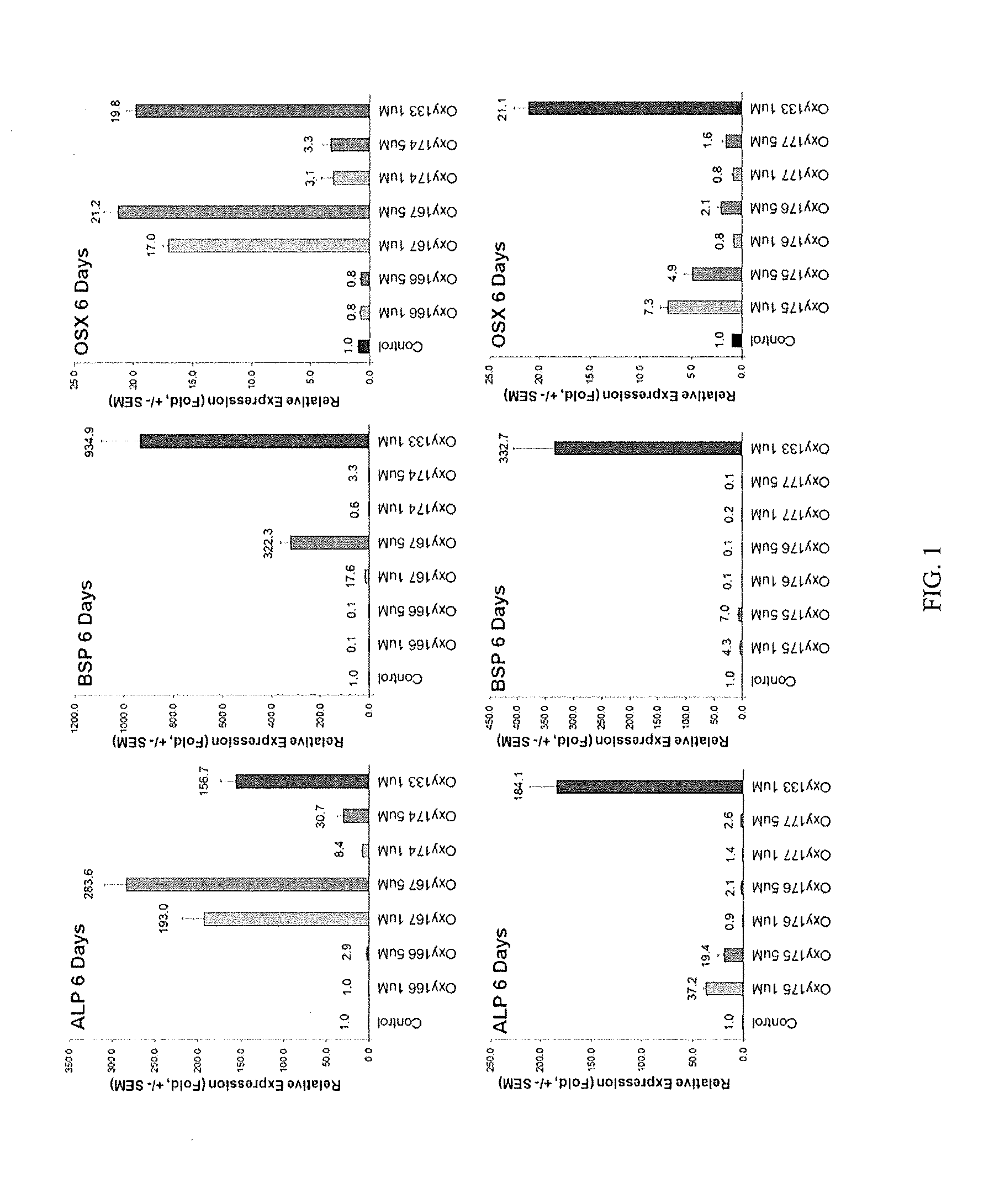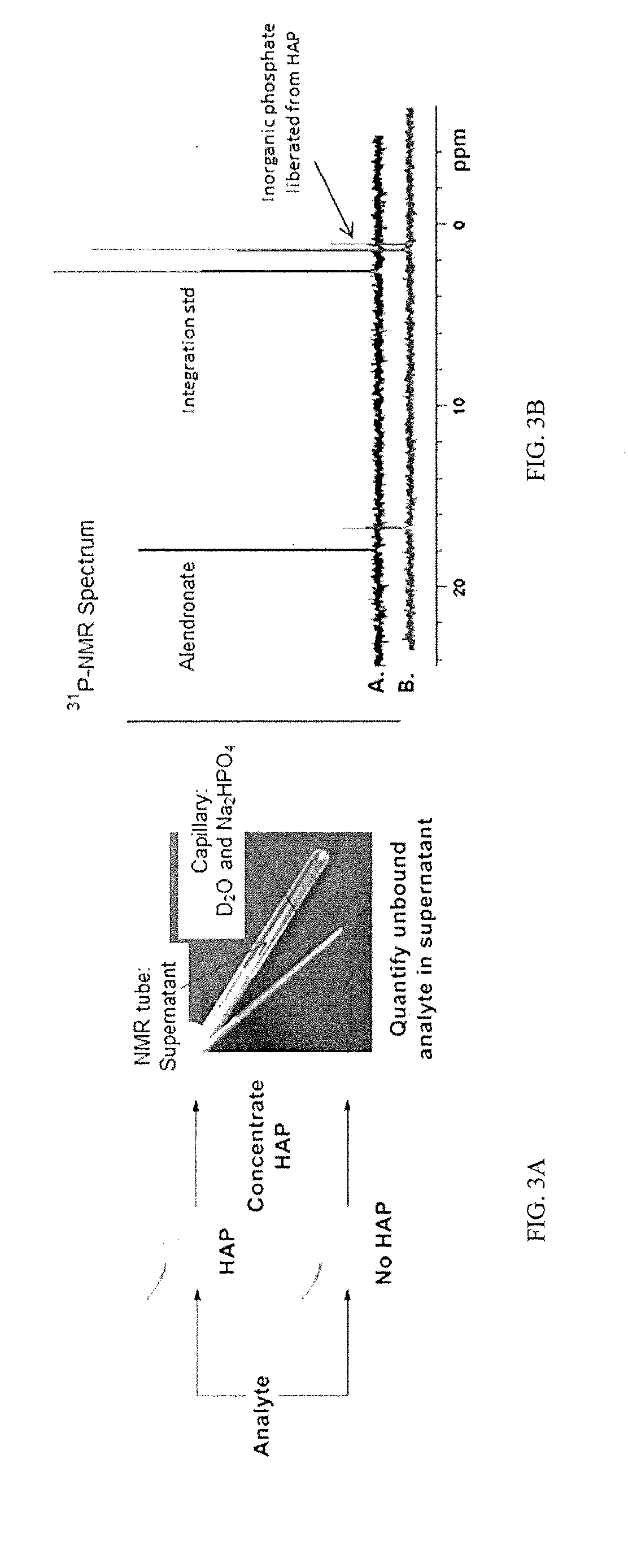Bone-selective osteogenic oxysterol bisphosphonate analogs
a technology of osteogenic oxysterol and analogs, applied in the field of bone-selective osteogenic oxysterol bisphosphonate analogs, can solve the problems of significant socio-economic cost, significant morbidity and mortality in the aging population, deterioration and death of otherwise healthy and functioning elderly individuals,
- Summary
- Abstract
- Description
- Claims
- Application Information
AI Technical Summary
Benefits of technology
Problems solved by technology
Method used
Image
Examples
example 1
Synthesis of Oxy166 and Intermediates
[0037]
[0038]OXY166 has succinate-linker units attached to the 3 and 6-positions of OXY133. OXY166 can be synthesized directly from OXY133 and requires no protecting group manipulation.
[0039]Oxy133 (236 mg, 5.61×10−4 mol, 1 eq) was dissolved in 5 mL of dichloromethane with DMAP, 4-dimethylaminopyridine, (6.8 mg, 5.61×10−5 mol, 0.1 eq) and triethylamine (566 mg, 5.61×10−3 mol, 10 eq). Succinic anhydride (449 mg, 8.42×104, 8 eq) was added as a solid and the mixture was stirred at room temperature overnight. In the morning, the solution was diluted in 1N aqueous HCl and extracted with dichloromethane. The combined dichloromethane portions were washed once with water then dried with Na2SO4 and concentrated to give crude 8. To crude 8 was added to N,N′-dicyclohexylcarbodiimide, DCC, (208 mg, 1.0×10−3 mol, 1.8 eq) and N-hydroxysuccinimide (101 mg, 1.0×10−3 mol, 1.8 eq) which was then dissolved in 2.5 mL of dichloromethane and stirred vigorously overnigh...
example 2
Synthesis of Oxy167 and Intermediates
[0041]OXY167 has a succinate-linker unit attached to the 6-position of OXY133. This attachment can be achieved by coupling of Oxy133 to succinic anhydride to yield an intermediate 13. Activated ester coupling to alendronic acid in aqueous media can yield compound OXY167.
[0042]Intermediate 6 (300 mg, 5.61×10−4 mol, 1 eq) was dissolved in 5 mL of dichloromethane and with 4-dimethylaminopyridine, DMAP (6.8 mg, 5.61×10−5 mol, 0.1 eq) and triethylamine (283 mg, 2.24×10−3 mol, 5 eq). Succinic anhydride (84 mg, 8.42×10−4, 1.5 eq) was added as a solid and the mixture was stirred at room temperature overnight. In the morning, the solution was diluted in 1N aqueous HCl and extracted with dichloromethane. The combined dichloromethane portions were washed once with water then dried with Na2SO4 and concentrated to give 365 mg of crude 12. The crude 12 was dissolved in 2 mL of a 1:1 mixture of DCM:MeOH to which para-toluenesulfonic acid monohydrate (11 mg, 5.6...
example 3
Synthesis of Oxy174 and Intermediates
[0043]OXY174 has a succinate-linker unit attached to the 3-position of OXY133. OXY174 is synthesized by reacting OXY133 with succinic anhydride to yield intermediate 10 which is activated as the N-hydroxy succinimide ester, 23, prior to reaction with alendronate tetra-n-butyl ammonium salt.
[0044]To a solution of OXY133 (80 mg, 1.9×10−4 mol, 1 eq) in 2 mL dichloromethane was added triethylamine (0.08 mL), DMAP (˜1 mg, 0.05 eq) and succinic anhydride (20 mg, 1.9×10−4 mol, 1 eq). The mixture was stirred at room temperature for six hours after which a second portion of succinic anhydride was added (20 mg, 1 eq). After 18 hours at room temperature, the reaction mixture was diluted with saturated NaHCO3 solution (20 mL) and dichloromethane (10 mL). The layers were separated and the aqueous layer extracted with dichloromethane (3×10 mL). The combined organic layers were washed with 0.5 M HCl solution and water, dried over Na2SO4 and the solvent evaporat...
PUM
| Property | Measurement | Unit |
|---|---|---|
| pH | aaaaa | aaaaa |
| weight | aaaaa | aaaaa |
| weight | aaaaa | aaaaa |
Abstract
Description
Claims
Application Information
 Login to View More
Login to View More - R&D
- Intellectual Property
- Life Sciences
- Materials
- Tech Scout
- Unparalleled Data Quality
- Higher Quality Content
- 60% Fewer Hallucinations
Browse by: Latest US Patents, China's latest patents, Technical Efficacy Thesaurus, Application Domain, Technology Topic, Popular Technical Reports.
© 2025 PatSnap. All rights reserved.Legal|Privacy policy|Modern Slavery Act Transparency Statement|Sitemap|About US| Contact US: help@patsnap.com



